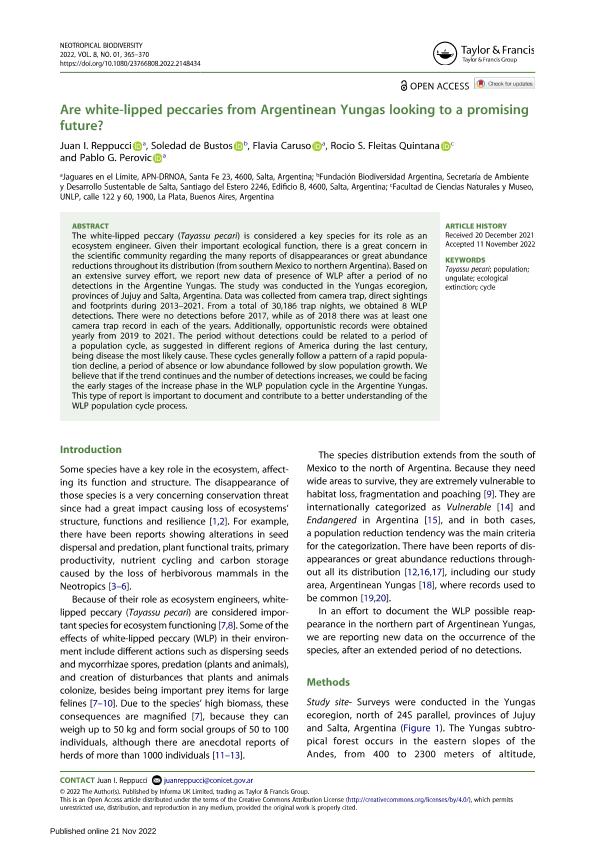Mostrar el registro sencillo del ítem
dc.contributor.author
Reppucci, Juan Ignacio

dc.contributor.author
de Bustos, María Soledad

dc.contributor.author
Caruso, María Flavia

dc.contributor.author
Fleitas Quintana, Rocio Soledad

dc.contributor.author
Perovic, Pablo Gastón

dc.date.available
2023-08-10T12:42:17Z
dc.date.issued
2022-11
dc.identifier.citation
Reppucci, Juan Ignacio; de Bustos, María Soledad; Caruso, María Flavia; Fleitas Quintana, Rocio Soledad; Perovic, Pablo Gastón; Are white-lipped peccaries from Argentinean Yungas looking to a promising future?; Taylor & Francis Ltd; Neotropical Biodiversity; 8; 1; 11-2022; 365-370
dc.identifier.issn
2376-6808
dc.identifier.uri
http://hdl.handle.net/11336/207749
dc.description.abstract
The white-lipped peccary (Tayassu pecari) is considered a key species for its role as an ecosystem engineer. Given their important ecological function, there is a great concern in the scientific community regarding the many reports of disappearances or great abundance reductions throughout its distribution (from southern Mexico to northern Argentina). Based on an extensive survey effort, we report new data of presence of WLP after a period of no detections in the Argentine Yungas. The study was conducted in the Yungas ecoregion, provinces of Jujuy and Salta, Argentina. Data was collected from camera trap, direct sightings and footprints during 2013–2021. From a total of 30,186 trap nights, we obtained 8 WLP detections. There were no detections before 2017, while as of 2018 there was at least one camera trap record in each of the years. Additionally, opportunistic records were obtained yearly from 2019 to 2021. The period without detections could be related to a period of a population cycle, as suggested in different regions of America during the last century, being disease the most likely cause. These cycles generally follow a pattern of a rapid population decline, a period of absence or low abundance followed by slow population growth. We believe that if the trend continues and the number of detections increases, we could be facing the early stages of the increase phase in the WLP population cycle in the Argentine Yungas. This type of report is important to document and contribute to a better understanding of the WLP population cycle process.
dc.format
application/pdf
dc.language.iso
eng
dc.publisher
Taylor & Francis Ltd

dc.rights
info:eu-repo/semantics/openAccess
dc.rights.uri
https://creativecommons.org/licenses/by-nc-sa/2.5/ar/
dc.subject
CYCLE
dc.subject
ECOLOGICAL EXTINCTION
dc.subject
POPULATION
dc.subject
TAYASSU PECARI
dc.subject
UNGULATE
dc.subject.classification
Zoología, Ornitología, Entomología, Etología

dc.subject.classification
Ciencias Biológicas

dc.subject.classification
CIENCIAS NATURALES Y EXACTAS

dc.title
Are white-lipped peccaries from Argentinean Yungas looking to a promising future?
dc.type
info:eu-repo/semantics/article
dc.type
info:ar-repo/semantics/artículo
dc.type
info:eu-repo/semantics/publishedVersion
dc.date.updated
2023-07-28T17:21:48Z
dc.journal.volume
8
dc.journal.number
1
dc.journal.pagination
365-370
dc.journal.pais
Reino Unido

dc.description.fil
Fil: Reppucci, Juan Ignacio. Consejo Nacional de Investigaciones Científicas y Técnicas; Argentina
dc.description.fil
Fil: de Bustos, María Soledad. Fundación Biodiversidad Argentina; Argentina
dc.description.fil
Fil: Caruso, María Flavia. Consejo Nacional de Investigaciones Científicas y Técnicas; Argentina
dc.description.fil
Fil: Fleitas Quintana, Rocio Soledad. Universidad Nacional de La Plata. Facultad de Ciencias Naturales y Museo; Argentina. Consejo Nacional de Investigaciones Científicas y Técnicas; Argentina
dc.description.fil
Fil: Perovic, Pablo Gastón. Consejo Nacional de Investigaciones Científicas y Técnicas; Argentina
dc.journal.title
Neotropical Biodiversity
dc.relation.alternativeid
info:eu-repo/semantics/altIdentifier/url/https://www.tandfonline.com/toc/tneo20/current
dc.relation.alternativeid
info:eu-repo/semantics/altIdentifier/doi/http://dx.doi.org/10.1080/23766808.2022.2148434
Archivos asociados
